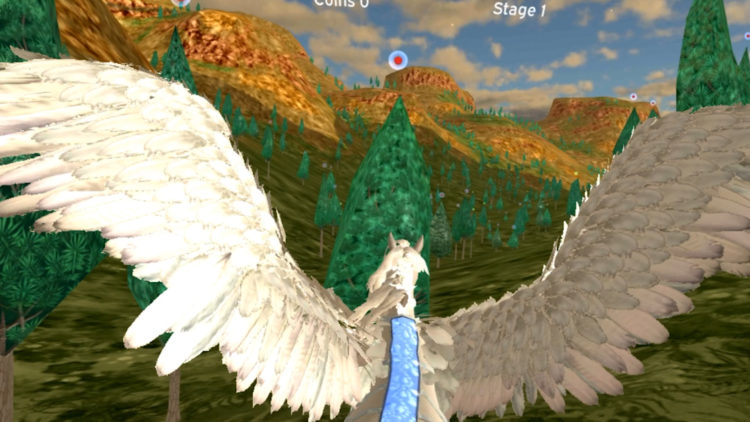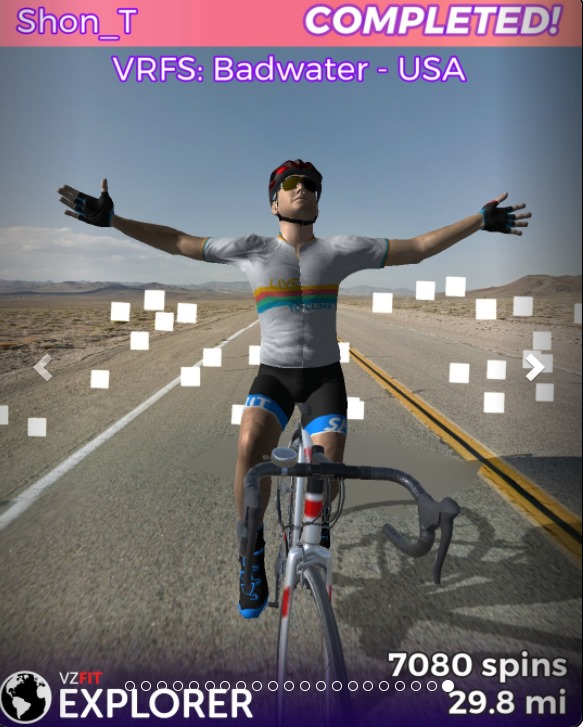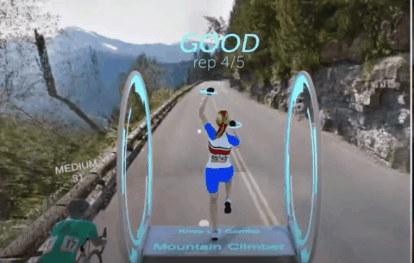As part of their participation in the recent inaugural VR Fitness Summit, Virzoom invited me to a virtual sit down with them to discuss the history so far of their excellent VZ Fit indoor biking VR product, and where they are heading in the future.
I spoke with Virzoom CEO Eric Janszen and CTO Eric Malefeew. Malefeew’s background as a developer integrating accessories into computer gaming technology is extensive spanning 25 years. Formally with Harmonix, he was a lead engineer and one of the creative forces behind Guitar Hero, Rock Band, and Dance Central. Introducing the interview, but not part of the discussion was Robert Collins, Virzoom’s Ride Finder, and Keeper, and for many VZFit enthusiasts, the bearded face of Virzoom as he works tirelessly to interact and assist members within the VZFit Facegroup and handles all the monthly update video reports.
You can watch the full video of the talk below and I’ve also summarised the major talking points, with some exciting future developments, including an entirely new game mode, that enables users to enjoy VZFit Explorer, without a bike at all, just using their controllers and head tracking!
Beginnings
We began the conversation with Janszen and Malefeew discussing their early adoption of VR tech. They began prototyping ideas as far back as 2014 and the launch of the Oculus developer kit (DK1). Janszen as an avid cyclist was keen to implement biking into virtual reality, and Malefeew’s technical experience helped to bring this vision to fruition. Embracing virtual reality’s potential for the fantastic they quickly realized that the physical bike you are sitting on need not actually be represented as a bike in VR. They began experimenting with other avatars, including a horse that could fly. The sense of connection that early testers reported that they felt to the horse along with the wonder at leaving the ground and soaring over the skies encouraged Vizroom that they were on the right path and the horse eventually became the winged Pegasus now featuring in several minigames within the eclectic game mix in VZFit Play. They also decided to embrace VR’s potential for gamification, exploiting computer game’s intrinsic rewards to motivate the player to continue cycling rather than requiring calorie counters and time/distance displays.
There is now some sound scientific research that confirms the benefits of this approach. As Janszen explains, in a recent study conducted with participants using the VZFit to cycle in virtual reality, both their exercise performance and enjoyment perception were increased when using VZFit versus a control group riding traditional exercise bikes. The experimenters concluded that was in large part because the participants using VR had a larger number of ‘dissociative thoughts’, or in layman’s terms riding in VR gave them other more enjoyable experiences to focus on that distracted them from the negative pain and exertion felt when exercising, riding a flying Pegasus will do that.

Invention and Reinvention
We also discussed the evolution of the product itself. It’s interesting that Virzoom, despite being software engineers initially felt compelled to manufacture the physical bike themselves, as the most frictionless way to enable consumers to get started. Assuming they already had a VR headset, and back in the early days that exclusively meant a tethered PC VR one, they only needed to purchase the bike to get started.
As Janszen points out one drawback to designing a bike for use is that it’s impossible to create a ‘one size fits all’ indoor bike. Serious exercises want a rugged watt controlled bike capable of delivering hundreds of watts resistance, whilst an overweight user may require an adapted bike capable of taking more user weight. Others might prefer a recumbent style bike over an upright or spin bike.
Therefore one early milestone for Virzoom was to take advantage of technology improvements in Bluetooth connectivity enabling them to dispense with their own bike product and instead release a more affordable sensor kit that could be attached to the pedal of any stationary bike, and for this cadence sensor to connect via Bluetooth to the VR headset.
And speaking of headsets, an exciting new world of opportunity opened up with the release of standalone, untethered VR from Oculus, in the form of the Oculus Go and Oculus Quest headsets. Once again Virzoom adapted, and decided to migrate their VZFit platform from tethered PCVR headsets to standalone mobile devices. Malefeeew touches on some of the technical difficulties that had to be overcome but overall this was a major step forward, as VR’s future, and especially when related to exercise is going to be standalone.
The final evolution came earlier this year when improvements to third party manufacturer Bluetooth sensor technology advanced to the point that Virzoom felt confident in recommending several third-party sensors as ways to connect a bike to their VZFit software. A short trial was so successful that at the start of this summer Virzoom discontinued its own VZFit sensor kit as there now exists a plethora of affordable ways to use a third-party sensor to connect to VZFit.
Tracing Virzoom’s journey is a great showcase for just how fast and how far VR technology has evolved in just a few short years. From initially needing a specifically made bike to use with a tethered PCVR headset connected to a powerful PC, we now have a situation where any user can enjoy VZFit’s excellent apps on any indoor bike, using a cheap third party sensor for under $20 and have a mobile virtual reality experience without wires that can be used anywhere.

An Exciting Future – New Game Mode and an Oculus Quest Store Launch.
Which brings us to the present day, and a look at what Virzoom has in store for us in the months to come. Since launching their product Virzoom has constantly striven to smooth out as many areas of friction that existed and served as potential barriers and obstacles to consumers being able to engage with their product. Now they are set to go one step further and introduce a full head and controller tracked workout, within VZFit Explorer that doesn’t require a bike at all.
In the upcoming game mode, instead of pedaling a bike to move through the environment users will now also have the option of moving their body through a series of workouts, with your squats, punches, and dance moves driving your forwards. The gif below gives a taster of how it will work.

This certainly opens some novel and fun new ways to travel through the world as well as allowing users without a bike to get a taste of walking, dancing, or punching their way through VZFit Explorers’ 3D Google Streetview worlds. Eric Janszen acknowledged that even aside from the workout benefits, for many just being able to physically walk through Google Streetview will make for a stellar travel app, something Virzoom is aware of and keen to expand upon. I think this will make for some immersive city walking tours!
Eric Malefeew also revealed that Virzoom has intentions of creating new experiences for controllers within VZFit Play as well. Oculus themselves appear to be impressed as they have now been accepted for an official Oculus Quest store launch, scheduled for early next year.
I can’t wait to try this new game mode and can hopefully bring a hands-on look at some beta access soon!











